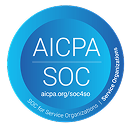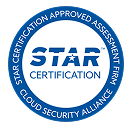Running a services business often feels like walking a tightrope. You’re trying to deliver client projects on time while keeping your teams motivated, your margins intact, and your pipeline steady. Three words loom like constant challenges: predictability, profitability, and repeatability.
These three pillars are critical to sustainable growth, yet many leaders struggle to balance them amidst the day-to-day demands of delivery.
In a recent Rocketlane webinar, we hosted two seasoned experts from Garwood Growth, John Howard and Robert Gartner, to share their insights and frameworks on how services firms can address these challenges head-on. Established in 2018, Garwood Growth is a specialist advisory firm that helps tech and professional services organizations accelerate growth, improve operations, and realize value.
Read on for the key takeaways from the webinar.
The Value Builder framework for predictability, profitability, and repeatability
Predictability means knowing what’s coming, whether your revenue forecasts are reliable, and whether your delivery margins will hold. Profitability means ensuring that the effort you put in consistently translates into healthy returns. And repeatability means every client, no matter the project or the team, experiences the same level of quality.
The difficulty is that predictability, profitability, and repeatability depend on multiple moving parts. A problem with resourcing could easily spill into profitability. A lack of governance in sales undermines repeatability. A weak financial planning process clouds predictability.
That’s why the team at Garwood Growth created the Value Builder, a diagnostic framework designed to help organizations identify and resolve the root causes of unpredictability, profitability, and repeatability issues. It's a maturity model built around eight interconnected domains that make up a professional services business.
Each domain contains five to eight subdomains, with defined maturity levels that allow organizations to assess their current state and plan for improvement.
Here’s a breakdown of the eight domains:
1. Strategy and planning: This is the foundation of the framework. It focuses on clarifying your services business’s direction, including your vision, values, business strategy, and operating model. This domain ensures your value proposition and unique selling points are articulated and supported by a business plan that aligns your ambition with your capabilities.
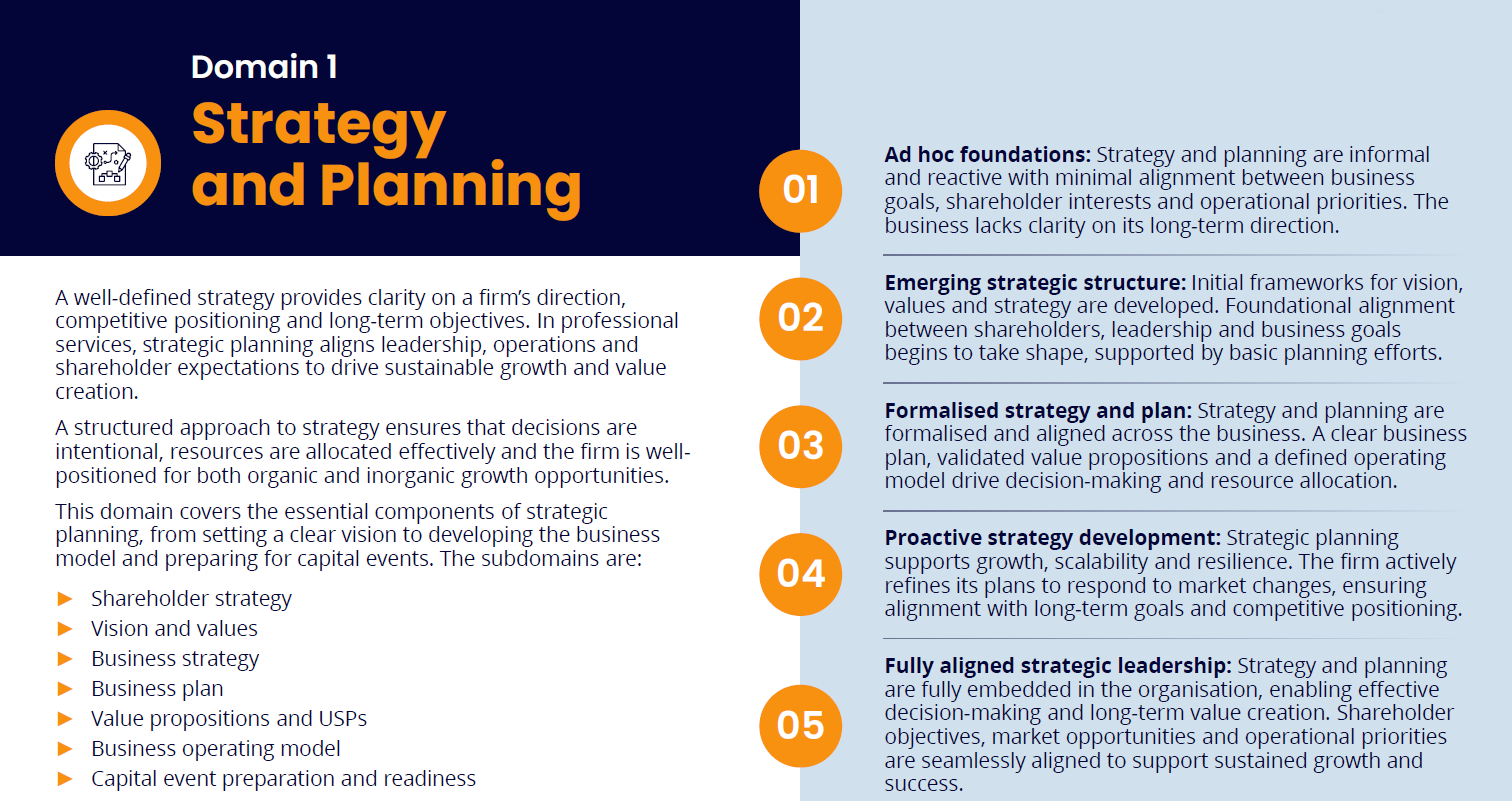
2. Leadership and governance: This domain provides the scaffolding for growth, focusing on building an effective management team, establishing board oversight, and embedding governance and risk management processes.

3. Sales, marketing, and clients: This area covers the commercial engine of your business. It includes your brand strategy, go-to-market planning, and lead generation. The goal is to build a repeatable and scalable sales process through sales enablement, disciplined governance to avoid non-standard exceptions, and the development of strategic alliances.
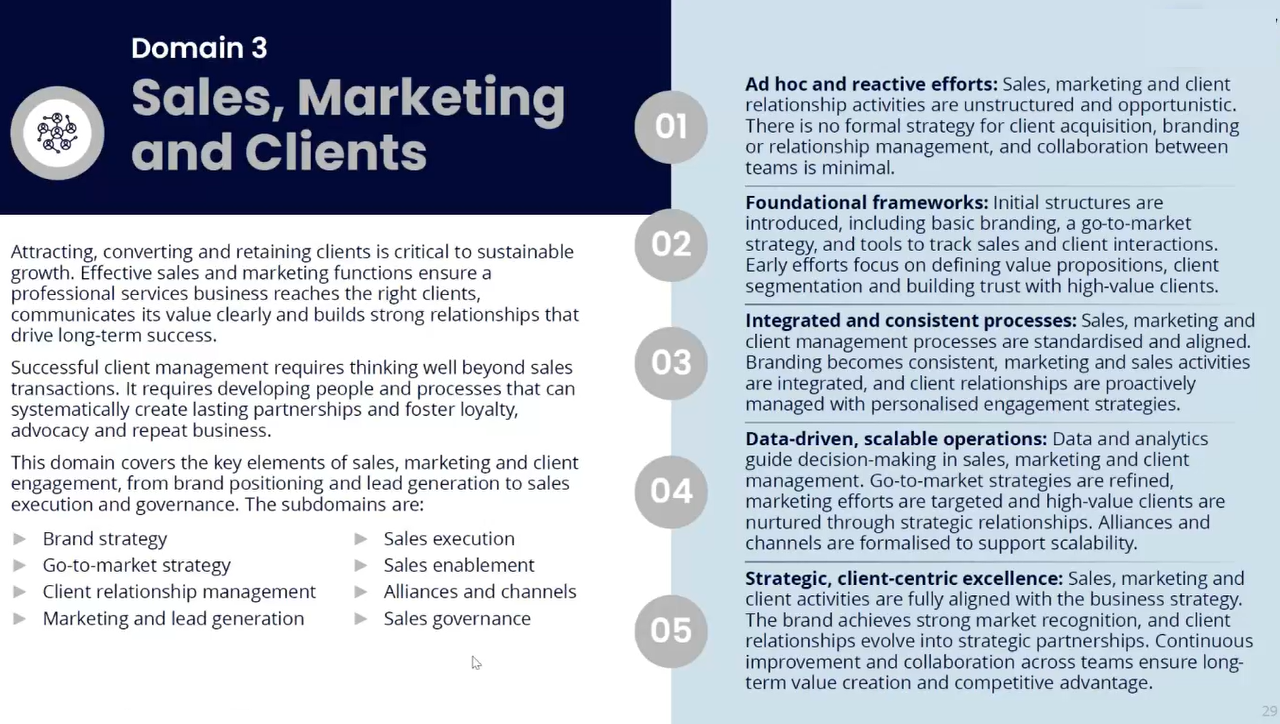
4. Service delivery: Delivery excellence is central to client satisfaction and repeatability. This domain spans execution, enablement, and resource management. The key is to codify your methodologies and intellectual property (IP) to ensure consistency, while using delivery governance to provide quality assurance.
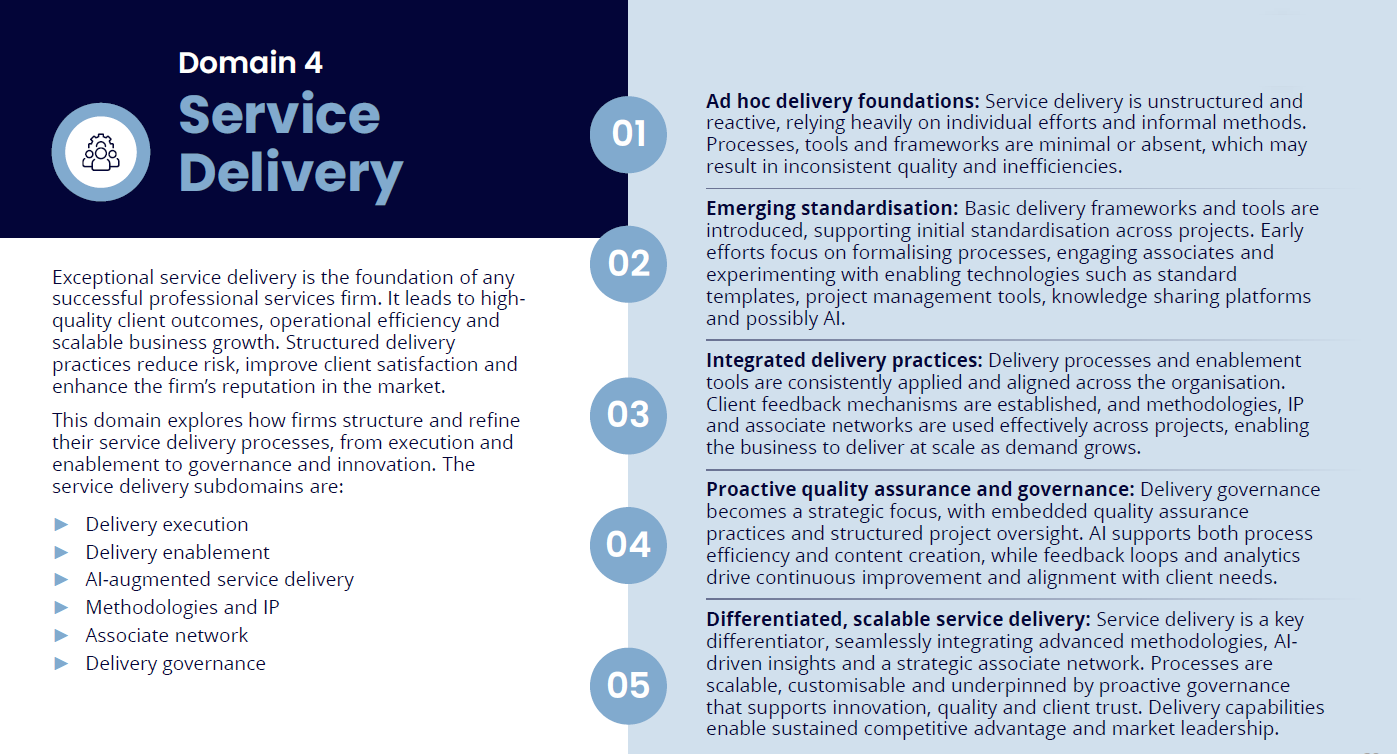
5. People, talent, and culture: This domain covers a thoughtful employee value proposition (EVP), recruitment, onboarding, and succession planning. It also includes compensation and rewards strategies that reinforce alignment and a focus on learning and development to reduce dependency on single experts.
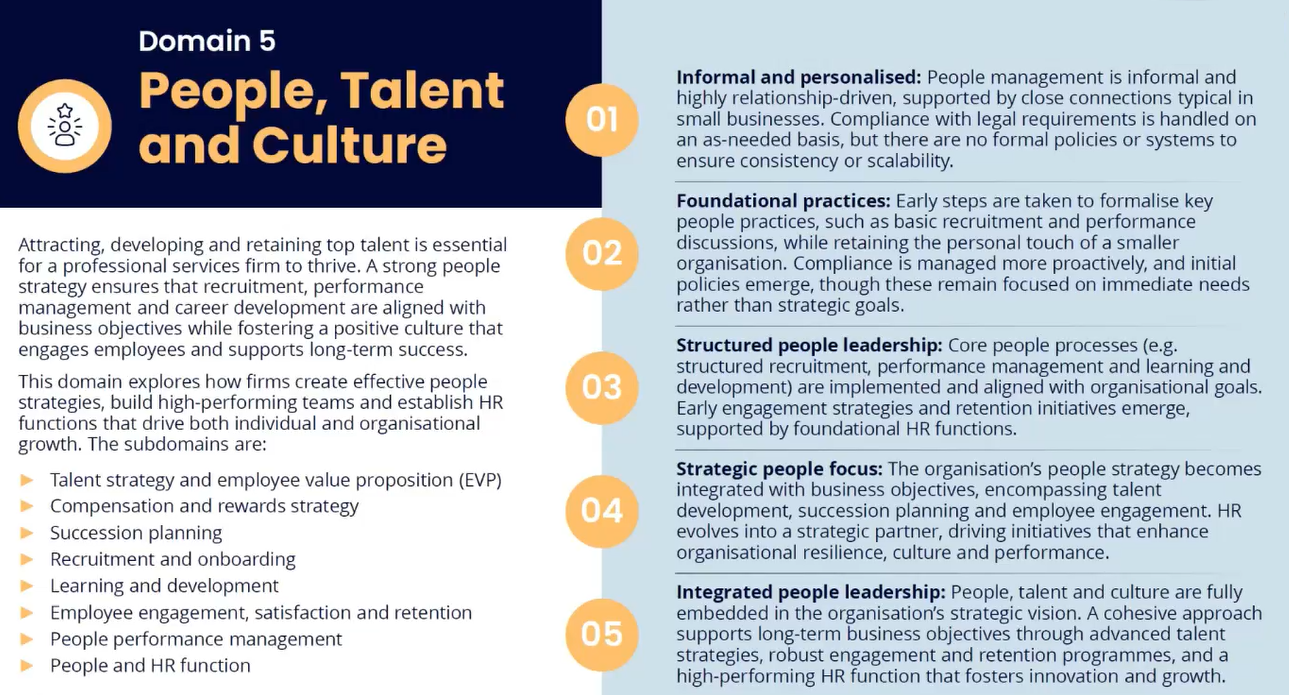
6. Finance, commercial, and performance: This domain covers the financial health of your business, including financial strategy, budgeting, and planning. It also focuses on tracking key performance indicators (KPIs) and using management information to drive visibility and performance.
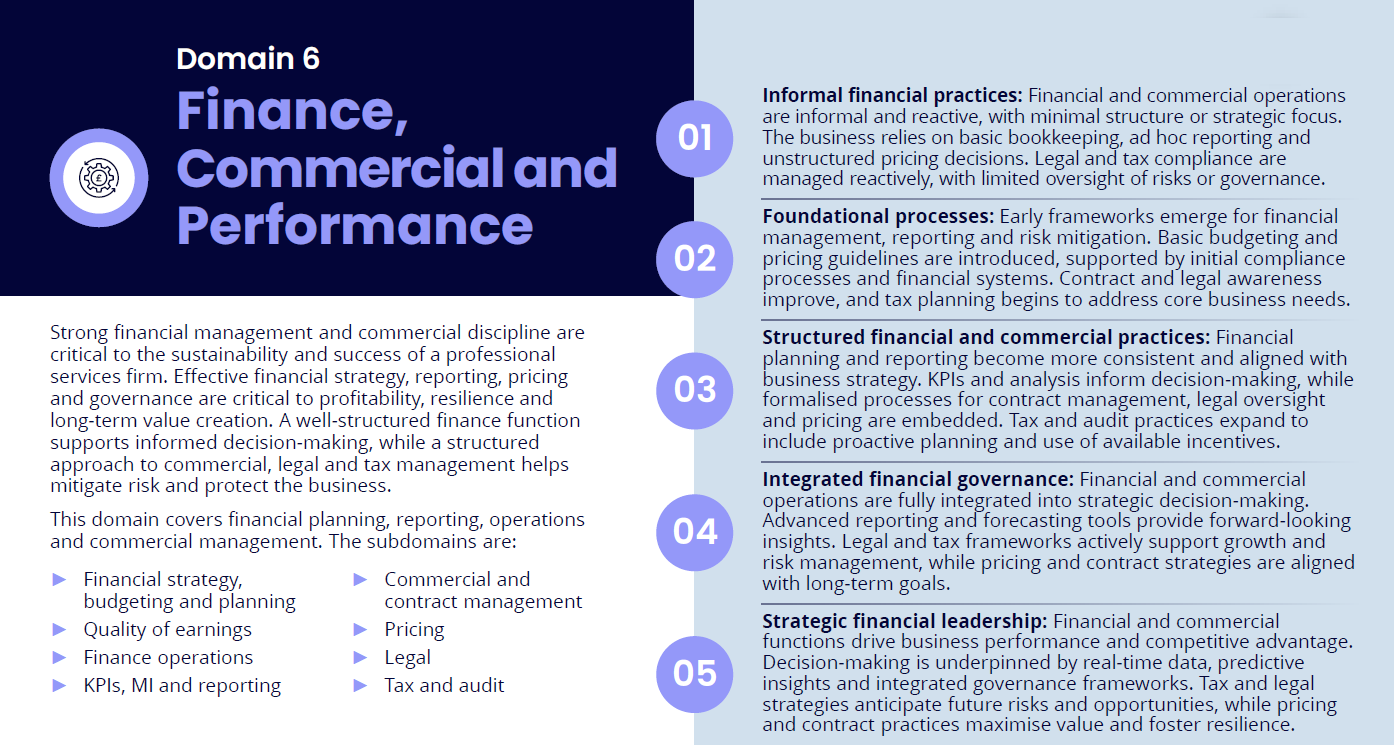
7. Business operations: This area spans the operational backbone of your firm, including IT, business systems and applications, and operations governance. It also includes knowledge management to ensure methodologies and learnings are captured and shared, as well as corporate social responsibility (CSR) and environmental, social, and governance (ESG) initiatives.
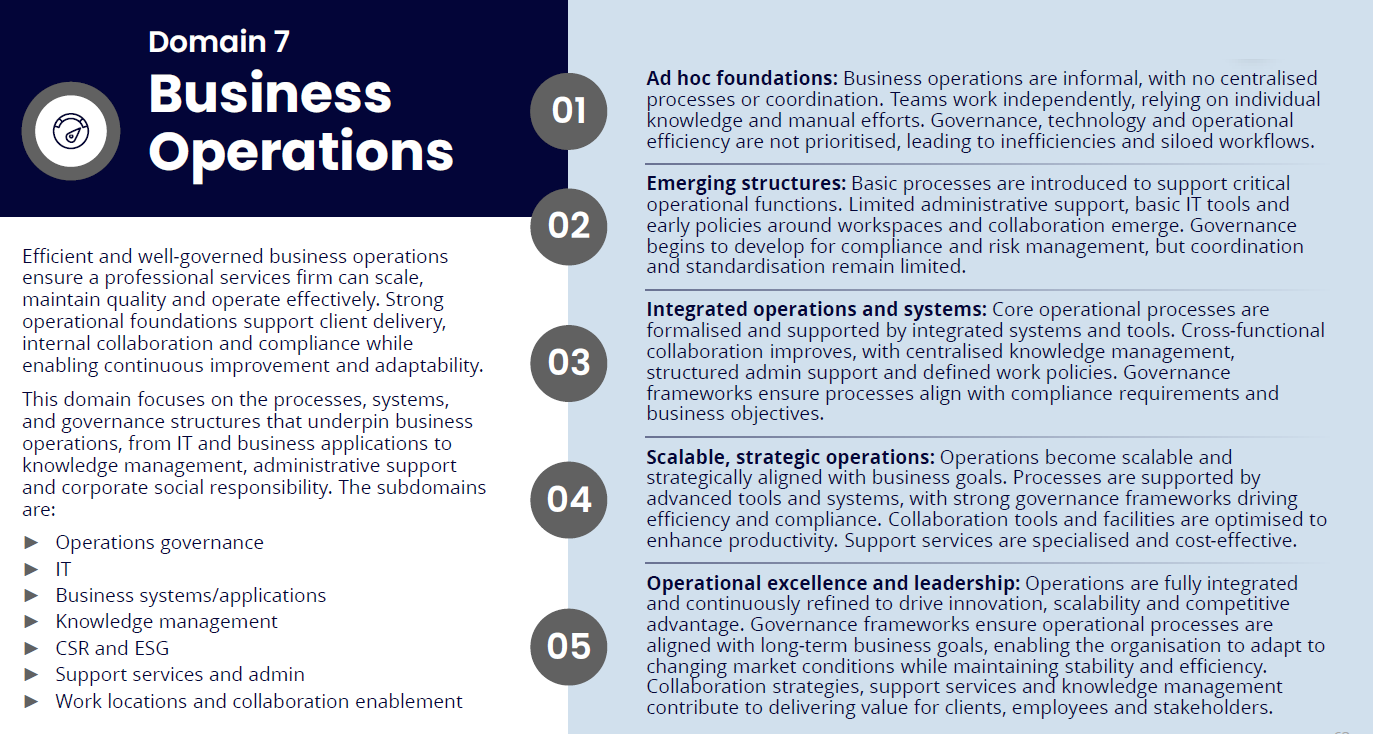
8. Inorganic growth and portfolio strategy: Beyond organic growth, firms can pursue value creation through mergers, acquisitions, and portfolio development. This requires a clear M&A strategy, disciplined target search, and effective post-merger integration to ensure expected benefits are realized.
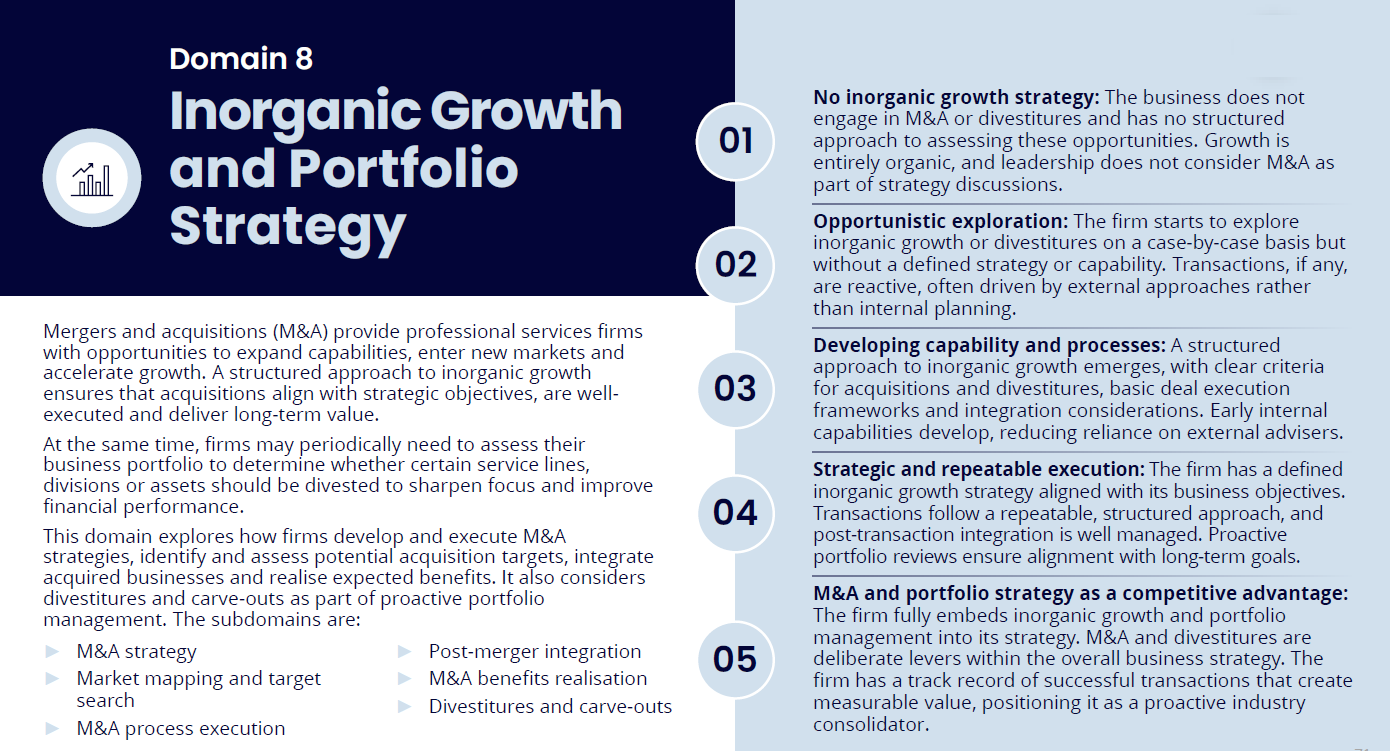
Check out the Value Builder framework to understand the domains and sub-domains in detail.
How the Value Builder framework strengthens predictability in services businesses
Predictability is one of the most difficult challenges for services firms. A lack of forward visibility undermines profitability and repeatability, creating a constant cycle of firefighting.
At its core, predictability is about ensuring that:
- Sold margin equals delivered margin, eliminating the gap that often erodes gross margin once projects are underway.
- Resource utilization is forecasted accurately, giving leaders a clear view of future availability and revenue potential.
- Revenue and operations are visible in advance, allowing the firm to intervene before performance slips.
Several patterns recur across services organizations, such as:
- Resource forecasting gaps: Many firms lack the systems to support accurate forward-looking forecasts. This leads to inefficiency, as leaders rely on manual solutions like all-hands meetings or spreadsheets to track what people are working on.
- Inflated support structures: A large internal support function that doesn't contribute to frontline delivery can drive down gross margin and profitability.
- Overly bespoke delivery: Over-customizing every solution for clients is inefficient. It raises costs, increases the risk of project overruns, and reduces profitability.
- Lagging management information: If management information is produced on a monthly cycle with a lag, it's often too late to intervene. Moving to a weekly cadence of KPI tracking allows leaders to act within the month, not after it.
The Value Builder framework offers a structured way to examine where unpredictability arises across several domains:
- Sales governance: Assesses the maturity of deal flow visibility at committed, possible, and probable levels. Strong governance over the pipeline allows for reliable revenue forecasts.
- Service delivery and resource management: Evaluates the effectiveness of delivery execution and resource allocation. Mature practices use professional services automation (PSA) tools integrated with CRM to provide visibility into both sold and pipeline work.

- Financial strategy and forecasting: Reviews how financial forecasts are built. Higher maturity means integrating committed revenue, weighted pipeline opportunities, and project timelines into rolling forecasts.
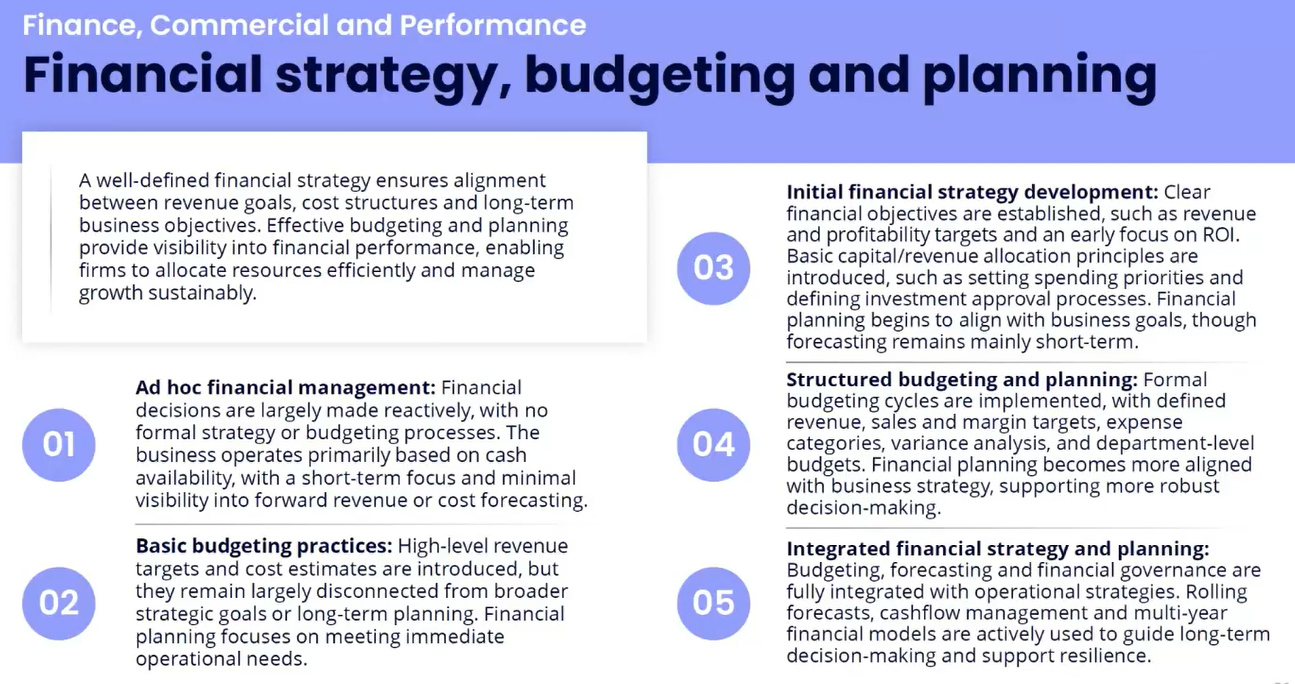
By scoring current practices against these domains (and associated sub-domains), firms can pinpoint the weak links that undermine predictability and prioritize improvements.
Using the Value Builder framework to assess and drive profitability
Profitability in professional and tech services comes down to one simple principle: ensuring the delivered margin matches the sold margin. However, several common issues can break down this alignment. These include:
- Scope creep: Poor change control is one of the most common margin killers. A small change that's not charged for can translate into a significant hit to profit.
- Resource allocation: Over-delivering by having senior, high-cost consultants perform work that could be handled by juniors inflates project costs and depresses margins.
- Invoicing delays: Late or incomplete time entries lead to late invoicing, which creates working capital inefficiencies and undermines sustainable profitability.
The Value Builder framework helps leaders examine where profitability erodes by focusing on several domains, such as:
- Pricing discipline: Assess the maturity of discounting practices. Sustainable profitability requires balancing a portfolio of higher and lower margin work. The framework highlights whether leaders have a clear margin forecast model and defined principles for when and why discounts are applied.
- Commercial and contract management: Review how effectively change control is governed. Scope creep on fixed-fee projects can erode predicted margin quickly. Mature practices apply disciplined change management to protect the financial outcome of engagements.
- Resource management: Evaluate how resources are allocated. Assigning senior consultants to work that could be done by less costly staff inflates delivery costs and suppresses margin. The framework identifies maturity in internal approval and allocation processes that prevent resource inflation.
- Sales governance: Examine the role of deal reviews in protecting margin. Mature firms introduce structured approval points before proposals and contracts are signed. A margin review at each stage helps ensure that the sold margin is realistic and achievable in delivery.
By scoring current practices against these domains, leaders can identify where profitability is undermined, from weak discount discipline to over-resourcing projects. The Value Builder provides a lens to align sold margin with delivered margin and create a more sustainable profitability model across the firm.
Using the Value Builder framework to assess repeatability
Repeatability is about delivering a consistent client experience across engagements. The Value Builder framework highlights several domains where repeatability can be assessed:
- Service delivery: Review how far methodologies and intellectual property (IP) are codified. Mature practices use delivery frameworks with quality assurance to ensure every project meets the same standards. Delivery enablement is also key: templating proposals, project plans, and outputs reduces variation and accelerates delivery while maintaining consistency.

- Knowledge management: Examine how knowledge and templates are captured, stored, and shared. A central knowledge base makes proven methodologies accessible, supporting both efficiency and consistency in delivery.
- People, talent, and culture: Evaluate learning, development, and performance management practices. Reducing single points of expertise through structured L&D ensures skills are spread across the team. Performance management, supported by competency frameworks, sets personal standards that directly influence the consistency of client experience.
- Sales and delivery alignment: Assess how handoffs between sales and delivery are managed. Inconsistent transitions can undermine the client experience. Mature practices standardize handoff processes and govern exceptions to protect repeatability from the very first engagement stage.
Repeatability shifts an organization from relying on individual heroics to systematic, organization-wide excellence. When solutions are codified, teams are trained, and performance standards are enforced, clients experience consistency regardless of who delivers the work.
Walking the path from firefighting to intentional growth
For services firms, balancing predictability, profitability, and repeatability requires a structured path forward. The Value Builder framework gives leaders the lens to do just that:
- Determine: Identify whether predictability, profitability, or repeatability is the immediate priority.
- Assess: Map the firm across the eight domains to reveal maturity gaps and blind spots.
- Prioritize: Focus on the gaps that most directly drive margin leakage, inconsistent delivery, or lack of visibility.
- Act: Establish governance, processes, and tools to close those gaps, shifting from reactive fixes to steady, repeatable growth.
Q&A on driving and assessing predictability, profitability, and repeatability
What is the first thing to look at if delivery timelines keep slipping?
Start by looking at is the scope and whether the team is over-delivering. An organization’s first priority should be to ensure it is effectively controlling its responsibilities and the scope of work outlined with the client. Beyond that, it is important to manage the client's pace and ensure the people on the team have the skills to complete the work.
Where should firms look for leakages if they have decent utilization rates but low profits?
If utilization is high but profit is low, the first thing to look at is pricing. It's important to assess whether there is sufficient margin built into the pricing model from the outset. Another area to review is whether the right level of people are being used for the work, as using overqualified or overskilled staff can quickly drive up costs and depress margins.
In a scenario where founders still bring in the biggest deals, what's the first step to making sales more repeatable?
A key step in making sales more repeatable is for the founder to recognize that this is a problem that needs to be tackled. This issue is a common plateau point for organizations. To address it, you need to transition from a founder-led sales approach to a structured go-to-market strategy that includes professional marketing to drive lead generation and deal closure.
If margins vary widely from project to project, even with the same type of work, is that usually a pricing issue or a delivery issue?
It could be both. It could be that the margin at the point of deal or contract was suppressed due to under-scoping, a discount, or an issue with rates. Alternatively, it could be a delivery issue, such as resources being substituted or scope creep during the delivery phase.
How far realistically should firms be able to forecast resourcing without overcomplicating things?
A good time horizon for forecasting is three to six months. Most businesses can achieve this level of forward visibility without overcomplicating their processes.
When forecasting, be sure to include not only sold work but also opportunities in the pipeline. If your systems don't allow for tagging resources to pipeline opportunities, it's a key functionality to add, whether through a PSA or another management system.






